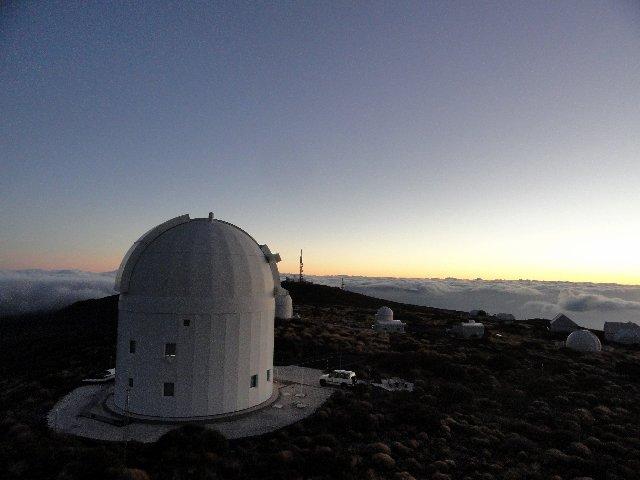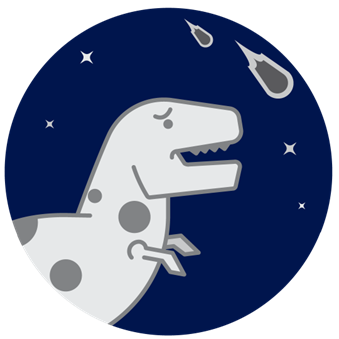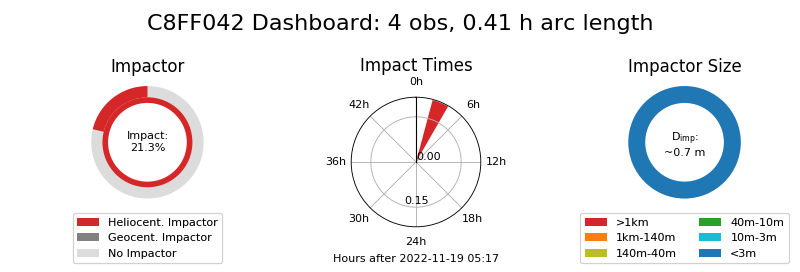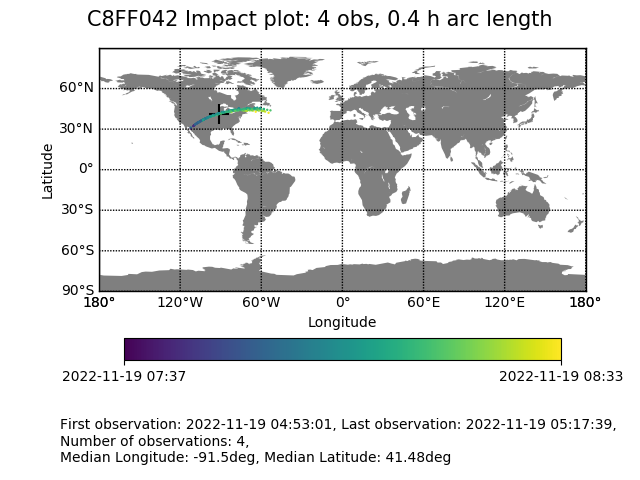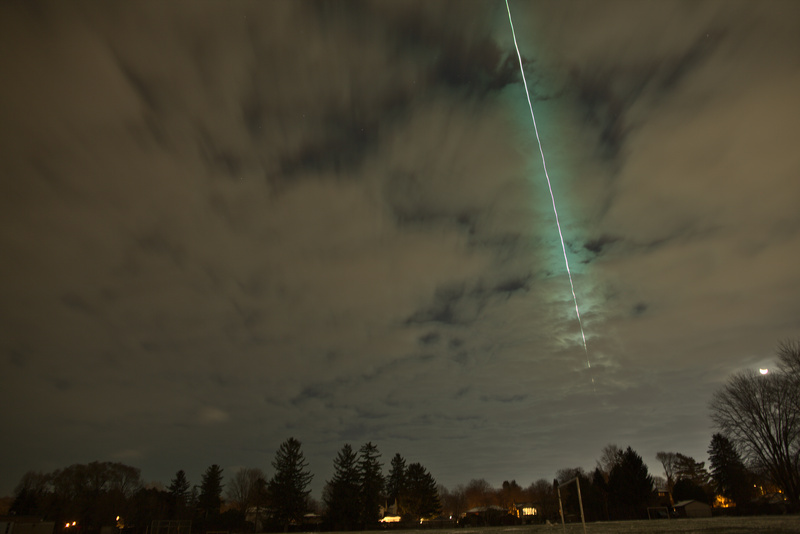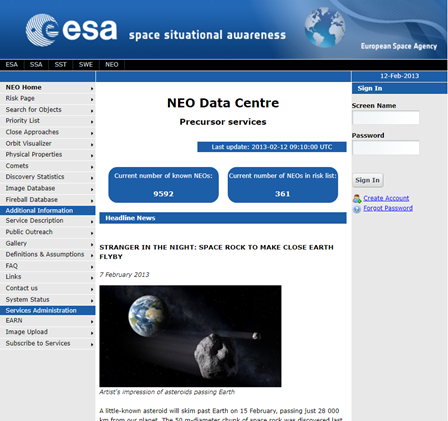News Details
2024 GJ2

operator neo
The ESA S2P-NEO Coordination Centre has released a Close Approach Fact Sheet (CAFS) for asteroid 2024 GJ2, passing by Earth on 11 April. Please, feel free to forward it to potentially interested people.
You can download the CAFS by clicking on the button below. For subscribing to our releases, please fill in the form on page https://neo.ssa.esa.int/subscribe-to-services.
April 2024

operator neo
The ESA SSA-NEO Coordination Centre has released the April newsletter summarising the most relevant data and events on asteroids and comets approaching the orbit of the Earth. Please, feel free to forward it to potentially interested people.
You can download the newsletter by clicking on the button below. To subscribe to the service, please fill in the form on page: https://neo.ssa.esa.int/subscribe-to-services.
The new Synodic Orbit Visualisation Tool for NEOs

operator neo
ESA’s NEO Coordination Centre has just expanded its suite of tools within the NEO Toolkit with the Synodic Orbit Visualisation Tool (SOVT). The SOVT is an advanced NEO trajectory visualiser which uses a rotating reference frame that follows the motion of Earth about the Sun. The tool allows to represent the relative trajectory of an NEO in a 3D synodic reference system. It can also show the NEO observability region in 3D for a certain telescope on Earth (defined by the telescope limiting visual magnitude), in a shape that we call the “detection polar”. This allows creating an instant overview about if and when an object might be observable. The tool makes use of the H-G magnitude system in order to compute this 3D detection polar.
Read the full article here.
Caption: Synodic trajectory of Apophis with respect to the Earth between March 2021 and March 2034. The observability of the asteroid in a telescope with a limiting visual magnitude of 18 mag is provided through the detection polar surfaces represented in yellow. Credits: ESA / PDO.
The new Synodic Orbit Visualisation Tool for NEOs

operator neo
ESA’s NEO Coordination Centre has just expanded its suite of tools within the NEO Toolkit with the Synodic Orbit Visualisation Tool (SOVT). The SOVT is an advanced NEO trajectory visualiser which uses a rotating reference frame that follows the motion of Earth about the Sun. The tool allows to represent the relative trajectory of an NEO in a 3D synodic reference system. It can also show the NEO observability region in 3D for a certain telescope on Earth (defined by the telescope limiting visual magnitude), in a shape that we call the “detection polar”. This allows creating an instant overview about if and when an object might be observable. The tool makes use of the H-G magnitude system in order to compute this 3D detection polar.
Read the full article here.
Caption: Synodic trajectory of Apophis with respect to the Earth between March 2021 and March 2034. The observability of the asteroid in a telescope with a limiting visual magnitude of 18 mag is provided through the detection polar surfaces represented in yellow. Credits: ESA / PDO.
The first of (hopefully) many

operator neo
Over the last year, ESA has commissioned and started operating the second so-called "Test-Bed Telescope" (TBT), a 56 cm wide-field optical telescope located on the premises of ESO's La Silla Observatory, on the Chilean Andes. This is the second unit, after the first one already installed in ESA’s tracking station in Cebreros, Spain. The TBTs have been designed to support NEO and space debris observations, and especially networked and collaborative experiments. They are intentionally composed of “commercial off-the-shelf” components, to demonstrate the capabilities of current instrumentation options and, in particular, to allow easy testing of novel observational approaches.
As a first test for these instruments as an NEO observing tool, we began operating the telescope almost nightly as a follow-up facility after it was assigned an MPC code W57 in late 2022. Observations from La Silla benefit from the extremely high percentage of clear nights and the Southern declination coverage offered by the telescope's location. The observatory quickly rose in the ranks of NEO follow-up facilities worldwide, significantly contributing to NEO confirmation efforts in the Southern hemisphere.
In recent months, however, we decided to devote a fraction of the telescope's time to NEO discovery survey. We developed a synthetic tracking pipeline, based on the Tycho Tracker software package and exposed and analysed a few fields per night. Our observing strategy alternates between low elongation fields and regular follow-up near the opposition region. Every candidate detection is carefully validated by our professional observers, to ensure that only reliable detections are submitted to the MPC and published.
Months of dedicated work finally paid off on Thursday, 14 March, when we were rewarded with our first discovery using this newly developed telescope and pipeline system. A set of images exposed in the Southern constellation of Hydra contained an unknown magnitude ~20.5 asteroid, which our observers immediately recognised as having a high likelihood of being real. The candidate was temporarily labelled PDO0002 and reported to the MPC, where it promptly appeared on the NEO Confirmation Page.
We immediately obtained follow-up observations with our network of telescopes and collaborators, including the Las Cumbres Observatory network, the Calar Alto Schmidt and the TRAPPIST North and South telescopes in Morocco and Chile. Thanks to the resulting astrometry we now know that the object is an NEO, similar in size to the Tunguska impactor, with a relatively small MOID of 0.006 au. Other stations also reported follow-up, and the Pan-STARRS team located a “prediscovery” unreported detection from two weeks earlier, which further improved the orbit determination.
The object has now been designated 2024 EL4. Aegis, our impact monitoring system, has processed all the available observations and shows that the object doesn’t pose any impact risk with Earth over the next century.
We hope that this discovery is just the first of many more to come, not just with these test-bed telescopes but also with ESA's dedicated discovery machine, the Flyeye telescope, which is ready to be installed and commissioned in Southern Italy.
Hot off the presses: just 4 days after discovering 2024 EL4, the same system found another NEO, which has now been confirmed and designated 2024 FS1.
Caption: The discovery image of 2024 EL4 was generated by stacking 31 images taken with a chilled CCD camera. Credits: ESA / PDO.
2018 LA, the third predicted NEO impact on Earth

neo admin
For the third time in recent history of asteroid detection a NEO was detected a few hours before it entered the Earth atmosphere (the two previous cases were 2008 TC3 and 2014 AA).
Asteroid 2018 LA was discovered by the Catalina Sky Survey in the early morning (European time) of this Saturday, 2 June.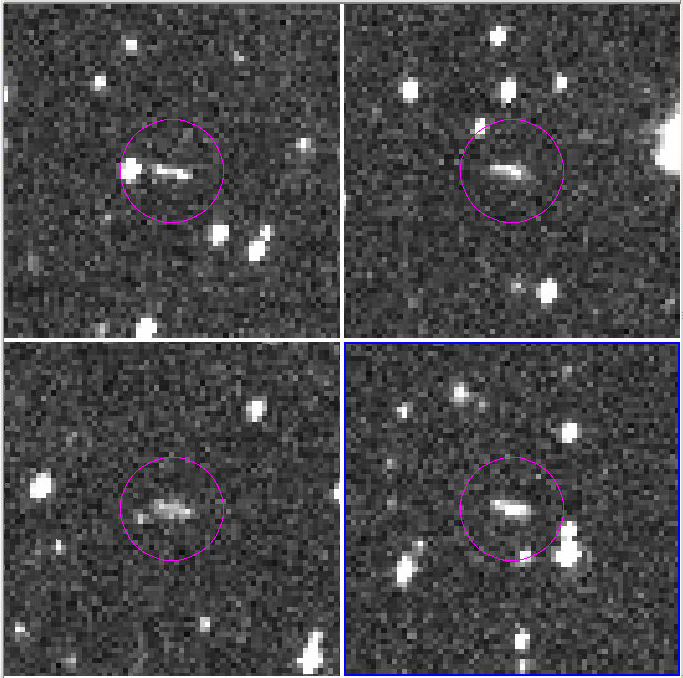
In a matter of hours additional observations were made and it became very probable that it would collide with the Earth. The approximate impact corridor was over a thin stripe crossing Botswana and Namibia. The same evening a number of local observations started to arrive at the International Meteor Organisation reporting a very bright fireball detected in the mentioned area. It was confirmed that the observed fireball actually corresponded to 2018 LA. Details about the observed fireball can be found here: https://www.imo.net/asteroid-2018-la-hit-the-atmosphere-over-botswana-on-june-2/
The object had a size of 2 to 5 m and approached the Earth with a relative velocity of approximately 17 km/s from the night side. Due to its small size and high entry velocity the object could only be detected on its final plunge to Earth. It is expected to have completely disintegrated in the atmosphere.
Discovery images of 2018 LA obtained on 2 June 2018 with the 1.5 m telescope at Mt. Lemmon, Arizona (USA). Credit: Catalina Sky Survey / University of Arizona / NASA
New imminent impactor found by European astronomer

operator neo
For the seventh time, a meteoroid has been discovered before impacting the Earth. This one-metre asteroid has been discovered by Krisztián Sárneczky with the 60-cm Schmidt telescope of the Piszkéstető Observatory in Hungary. It is his second discovery of an impactor, after the impact of 2022 EB5 less than a year ago, in March 2022.
At 20:18:07 UTC on 12 February 2023 the new asteroid, now officially designated 2023 CX1, was imaged from Piszkéstető Observatory in Hungary and reported with a second position to the MPC at 20:49 UTC. About 40 minutes later some follow-up observations reported by the Višnjan Observatory in Croatia confirmed the object, and at this point the various impact assessment systems found a 100% impact probability in the area of the English Channel between 02 and 04 UTC. The estimated asteroid size was around 1 meter of diameter and posed no risk of damage for the people in the area.
During the next seven hours astronomers all around the globe observed the object and pinpointed the impact corridor over the English Channel, with a trajectory coming from West to East. The object was observed up to around 10 minutes before impact, only 5 minutes before getting into Earth’s shadow and becoming unobservable. The last image was taken at 02:46:56 UTC, by our collaborators of the Rantiga Observatory in Italy.
The fireball event happened at the predicted time (02:59 UTC) and location, with observations mostly from Southern UK and France, but also from Belgium, the Netherlands and even Germany. It is likely that some fragments of the meteoroid may have survived the atmospheric pass and fell somewhere onshore close to the coast north of Rouen, in Normandy, France.
The team at ESA’s Planetary Defence Office contributed to the event both with the timely notifications from its Meerkat system, and with the use of a network of optical telescopes established for these occasions. The observing facilities were specifically chosen to provide data useful to increase the accuracy in the determination of the impact circumstances. Astrometry from South Africa, quickly after the initial trigger, and later from the US, extended the observational baseline to continents outside Europe, providing larger parallax. Also, in the few minutes before impact, they triggered accurately-timed observations useful to reduce uncertainty of the impact time to less than 1 second.
First impact assessment by ESA’s tool Meerkat as reported at 21:33 UTC with only 7 measurements, already indicating an impact probability of ~100%. Credit: ESA / PDO
First impact corridor reported by ESA’s tool Meerkat as reported at 21:33 UTC, with the actual impact time 02:59 UTC in the middle of the uncertainty window. Credit: ESA / PDO
Asteroid 2023 CX1 entering Earth's atmosphere captured in the skies over the southern Netherlands. Credit: Gijs de Reijke
Fifth notch for Planetary Defenders

operator neo
At 19:24 UTC on 11 March 2022, Krisztián Sárneczky discovered a new bright and fast moving object with the 60 cm Schmidt telescope of the Piszkéstető Observatory in Hungary. After collecting 4 observations in quick sequence, at 19:38 UTC he reported them to the Minor Planet Center, with the internal observer-assigned designation of Sar2593.
They were quickly published and used by the various impact assessment systems to estimate the possibility of an impact, which seemed unlikely at that time, with a probability of less than 1%.
In the meantime, he began collecting more observations, and at 20:16 UTC he submitted a second batch of 10 additional measurements, now extending the observed arc to about 40 minutes.
As soon as they were published and picked up by the automatic systems, a completely different scenario became clear. At 20:25 UTC ESA’s own internal monitoring system, called “Meerkat”, triggered an alert to our team, reporting a 100% chance of impact for the object. The expected impact time was between 21:21 and 21:25 UTC, less than an hour later. The impact location was already predictable with an accuracy of about a thousand kilometres, and was located a few hundred kilometres North of Iceland.
In response to this alert, and similar ones quickly distributed by other alert systems, many professional and amateur observers all over Europe and in Asia quickly began observing the imminent impactor. Detecting it was extremely challenging, since the object was already very close (less than 50 000 km from the Earth) and moving very fast in the sky.
Another observatory from Slovakia soon reported its successful observations, together with many more detections from the original discoverer. When added to the trajectory computation, they pinpointed the location of the impact with a precision of just a few seconds and kilometres: the asteroid was going to enter the upper layers of our atmosphere roughly 140 km South of the Jan Mayen island, at 21:22:42 UTC, less than 2 hours after being discovered. From its observed brightness, the object appeared to be very small, roughly a metre in diameter.
In the few minutes just before impact more observatories obtained detections, including a last set at 21:10 UTC, by our collaborators of the Kleť Observatory. Shortly after the expected time of impact the Minor Planet Center designated the asteroid as 2022 EB5, the fifth known impactor observed in space before hitting our planet, and the first discovered from Europe.
Some cameras on the Norwegian island of Jan Mayen (900 km from the coast of Norway) recorded at least the flash of light from the incoming object. No visual evidence has arrived from Iceland, located roughly 700 km away from the impact point, probably because of to low-altitude clouds.
Nevertheless, there is independent evidence that the impact did in fact occur thanks to the international network of infrasound detectors. Signals from the impact were detected from Iceland and Greenland, suggesting an energy release equivalent to 2 to 3 kt of TNT. This is more than what would have been expected from a metre-sized impactor, and pointed to a likely larger diameter of 3 to 4 metres. The discrepancy is likely the result of the measurement uncertainties in both the optical observations and the infrasound detections.
Predicted impact point and time computed by ESA’s imminent impactor alert system “Meerkat” at 20:25 UTC, with the initial 14 observations. The impact location was later refined with more observations, and proved correct. Credit: ESA / PDO
Asteroid 2022 EB5 detected by the Kleť Observatory at 21:10 UTC, less than 13 minutes before it impacted the Earth. Credit: Kleť Observatory
The great value of a big eye in the night sky

operator neo
Asteroid 2023 TB2 recently provided us with an interesting example of how important it is to have access to optimal telescope resources when presented with the threat of some specific asteroid.
This asteroid was discovered by the Catalina Sky Survey's Mt. Lemmon station on 3 October 2023, as a fairly typical magnitude 21 NEO candidate. It is a moderately large asteroid, estimated to be between 50 and 100 metres in diameter, and its orbit brings it close to the Earth every few years.
Within a few days, an initial orbit determination by ESA's impact monitoring system showed that future collisions with this asteroid were possible, every few years starting in 2083. In total, this asteroid would have about a 1 in 6000 chance of hitting our planet over the subsequent four decades.
The object was then bright and easy to observe, and observations kept coming in, leading to almost daily orbit updates. By 9 October, the overall impact probability had risen to 1 in 1400, and for the first time the asteroid reached level 1 on the so-called "Torino Scale", bringing it to the attention of the community of NEO observers.
With new observations over the next 3 weeks, the estimated impact probability changed a bit, but by the end of October it was still roughly 1 chance in 2100. There was a problem though: the object was now moving away from the Earth, and at the same time it was getting closer to the position of the Sun in the sky. This meant that it was getting much fainter (almost magnitude 24), but also much more challenging to observe from the ground (with an elongation of 60°), because objects close to the Sun are only above the horizon at nighttime for a short time window each night.
In order to get additional data, we needed a telescope capable of detecting a magnitude 24 asteroid in just a few minutes of observing time. In addition, the object's northern declination required a telescope in the Northern hemisphere, thus precluding the use of ESO's VLT as we typically do for these faint targets.
Fortunately, there's a telescope that is just perfect for this observation: Spain's 10.4-m Gran Telescopio Canarias (GTC), the largest single-aperture optical telescope on the planet. Thanks to our collaboration with Javier Licandro and Julia de León, researchers at the Instituto de Astrofísica de Canarias, who have granted time at the GTC, we had access to this great facility.
On the evening of 3 November 2023, GTC observed 2023 TB2 for about half an hour. In the resulting dataset, the asteroid was extremely well detected, allowing us to extract very accurate astrometric measurements of its position. When included in the orbit computation process, these measurements single-handedly improved our knowledge of the object's orbit by almost a factor of four, and allowed us to revise our estimates of the future impact probability, which dropped from 1 in 2100 to just 1 in 40 000.
Furthermore, thanks to the GTC observation, we now know the future trajectory of this asteroid well enough to easily re-observe it the next time it becomes visible, in 2025. We expect that additional observations taken at that time will likely fully clarify whether the small remaining impact threat remains or not, still half a century before a possible impact date and with plenty of time to organise a DART-like mission, in the unlikely chance the threat becomes significant.
Caption: Trajectory of 2023 TB2 projected over the Ecliptic plane and in a rotating reference frame that follows the Earth in its motion around the Sun. The asteroid is located in the position where it was observed by the GTC, which also corresponds to a position in the Northern side of the Ecliptic. N.B.: the Earth, Sun and asteroid sizes are not to scale, while the orbits are. Credits: ESA / PDO.
NEOCC provides up-to-date determinations of the Yarkovsky effect

operator neo
The Orbit Determination and Impact Monitoring system of the ESA NEO Coordination Centre, also known as Aegis, underwent a big update about one year ago. Since then, the Risk Assessment team at the NEOCC has been working to develop new automated services to make available to users.
One of the most important upgrades introduced in the system is an automated algorithm to identify NEOs whose dynamics are affected by the Yarkovsky effect. This effect is a non-gravitational force typically noticeable on small asteroids. This tiny force is caused by sunlight, which is absorbed by the asteroid surface and then re-emitted away as heat, causing a small but continuous thrust that subtly perturbs the orbit of small celestial bodies. This effect, which is inversely proportional to the object size (see figure), causes the semi-major axis of an NEA to drift, leading to significant positional uncertainties over time.
Understanding the Yarkovsky effect is important for several reasons: for accurate orbital predictions and reliable impact hazard assessment of NEAs, to get insights about the physical composition of asteroids, and to better understand the formation of asteroid families.
With the new algorithm we introduced, data about the Yarkovsky effect on NEAs will be updated after every monthly release of the Minor Planet Center, ensuring a continuous availability of the most recent data to users through our portal. A complete description of the procedure can be found in the corresponding paper published in Astronomy & Astrophysics. Up to now, our portal shows more than 340 positive detections of the Yarkovsky effect. This number is expected to grow in the next years with the beginning of the operational phase of new high-technology observational surveys, such as the Vera Rubin Observatory and the ESA Flyeye Telescope.
Caption: Diameter vs. Yarkovsky semi-major axis drift for all the detections with signal-to-noise ratio larger than 3. Black and green dots are NEAs for which the detection is accepted. Black dots are those objects for which the diameter is known, while green dots are those for which the diameter is only estimated by the physical model. Red dots are detections that are considered spurious by the algorithm, thus discarded. The blue dashed line is a linear fit of the data, which is completely compatible with the predicted 1/D trend with the diameter. Credits: ESA / PDO.
A new tiny impactor observed until shadow entrance

operator neo
Krisztián Sárneczky has repeated himself for the third time, finding another small imminent impactor just before its impact with Earth in Europe.
The story began on Saturday, 20 January, at 21:48 UTC, the time of the first discovery image obtained from the Piszkéstető Observatory. Less than 30 minutes later, collecting more images and detecting the asteroid, the first set of astrometric positions was received by the Minor Planet Center and posted on the NEO Confirmation Page with the temporary designation Sar2736.
With just 3 positions, it was nearly impossible to know that the object was on a collision course with our planet. However, just 20 minutes later, the discoverers reported 4 more positions, and that's when the impact monitoring systems, including our own Meerkat, produced its first impact alert. It already gave an impact probability of 100% for the object, with an impact location placed somewhere between Germany and Sweden.
The discoverers continued reporting astrometry, and was soon joined by other European observers. Within minutes, the impact event circumstances became clear: this small metre-sized asteroid was going to impact Earth less than two hours later, roughly 50 km west of Berlin, Germany.
Over the next couple of hours more than a dozen observatories in mainland Europe, and our team from Tenerife, were able to obtain follow-up observations, until the latest possible instant: at 00:25 UTC the asteroid entered the shadow of the Earth and disappeared from view, while still under the watch of the Schiaparelli Observatory in Italy (see image).
Less than 8 minutes later, it became visible again as a bright fireball, observed by dozens of people all across central Europe. Some of them had been alerted through social media posts triggered by our imminent impactor systems, closing the loop from NEO discovery to fireball event. And all over a period of less than two hours, from first alert to impact, a success story for both the NEO and the fireball communities.
The asteroid was designated as 2024 BX1 by the Minor Planet Center, just after its impact. Congratulations to Krisztián, the Piszkéstető Observatory and all involved for this impressive third success in less than 2 years, a truly remarkable achievement.
Caption: The last detection of 2024 BX1 (then known as Sar2736) obtained by Luca Buzzi from the Schiaparelli Observatory in Italy (MPC code 204). The exposure was started at 00:24:55 UTC. The asteroid is moving from the bottom to the top of the image (heading North), and it is visible as a fading trail, due to its entrance into Earth’s shadow over the following 10 seconds. Credits: L. Buzzi, G. V. Schiaparelli Observatory.
A significant number of large near-Earth asteroids will have close approaches over the next few years

operator neo
It is well known that the asteroid (99942) Apophis will have a very close approach with the Earth on 13 April 2029. The object will pass at a distance less than that at which the geostationary satellites orbit the Earth and will be visible to the naked eye from some parts of the world. Such a close approach by an object the size of Apophis typically occurs only once every 10 000 years.
To take advantage of this opportunity, ESA, NASA and other space agencies are planning dedicated space missions, or have extended other missions (as in the case of OSIRIS-REx, which is now called OSIRIS-APEX), to reach Apophis around this epoch.
While the case of Apophis in 2029 is certainly very noteworthy, it is also interesting to realise that in the period between mid of 2027 and the end of 2029 there will be several large NEAs that will have close approaches with the Earth (see figure below). In fact, during this 2-year period, the following five large known NEAs (in addition to Apophis) will pass within four lunar distances (LD) of Earth:
- (153814) 2001 WN5, with a diameter of 930 m and passing at 0.65 LD on 26 June 2028,
- (137108) 1999 AN10, with an estimated diameter of 800 m and passing at 1.01 LD on 7 August 2027,
- (35396) 1997 XF11, with a diameter of 700 m and passing at 2.42 LD on 26 October 2028,
- (292220) 2006 SU49, with an estimated diameter of 400 m and passing at 3.19 LD on 28 January 2029, and
- 2023 GQ2, with an estimated diameter of 400 m and passing at 3.95 LD on 16 November 2028.
If a rendezvous mission to one of these bodies were planned, the delta-V requirements for such a mission would be between 5 km/s and 15 km/s. For asteroid missions after Apophis, the situation is not exactly the same as in the 2-year interval mentioned, but there are still feasible candidates. These can be seen in the figure below, where the following medium to large objects will have approaches to Earth of less than 5 LD by 2040:
- 2002 NY40, with a diameter of 280 m and passing at 2.8 LD on 11 February 2038,
- 2021 TG4, with an estimated diameter of 400 m and passing at 2.9 LD on 4 May 2034,
- (536531) 2015 DV215, with an estimated diameter of 290 m and passing at 2.9 LD on 6 October 2035,
- (613403) 2006 GB, with an estimated diameter of 300 m and passing at 4.1 LD on 22 March 2037,
- 2021 PC7, with an estimated diameter of 500 m and passing at 4.2 LD on 16 September 2033,
- (216985) 2000 QK130, with an estimated diameter of 200 m and passing at 4.4 LD on 15 March 2036,
- (369057) 2008 DK5, with an estimated diameter of 200 m and passing at 4.5 LD on 28 February 2039,
- (549948) 2011 WL2, with an estimated diameter of 250 m and passing at 4.7 LD on 21 April 2038,
- 2019 OQ2, with an estimated diameter of 300 m and passing at 4.8 LD on 04 April 2039.
Therefore, alternative mission options could be flown to the above objects, which could also be filtered in terms of the delta-V required to reach them, and also in terms of their taxonomy and other properties.
Caption: Close approaches of known large NEAs by 2040 and the approximate delta-V required for a rendezvous mission. Plot based on an idea by Dotson et al. 2022. Credits: ESA / PDO
NEOCC turns 10

operator neo
ESA’s NEO Coordination Centre turned 10 years old this 22 of May. The Centre was inaugurated back in 2013 inside ESA’s ESRIN establishment close to Rome (Italy). It was a lucky coincidence that the Centre was opened just a few months after the most relevant asteroid impact event of the last hundred years, i.e. the Chelyabinsk event over Russia, which has fostered a surge on Planetary Defence activities ever since. The then ESA’s Space Situational Awareness Programme (since 2020 renamed as the Space Safety Programme) had been active since 2009 and had paved the way to the creation of the NEOCC.
At the time the NEOCC was inaugurated, slightly less than 10 000 NEOs had already been discovered. In just 10 years, that number has multiplied by more than three: during that period there have been twice as many discoveries as in the previous 100 years!
Since the start of operations of ESA’s NEOCC, the capabilities of the centre have steadily improved and expanded, starting from an initial federation of already existing services, and evolving into a fully independent operational system. A summary of some relevant achievements reached in these 10 years follows:
- May 2013: inauguration of the NEOCC at ESRIN, including the federation of several European NEO services (e.g. NEODyS data, EARN data, NEO chronology, NEO priority list, etc)
- April 2015: ESA and the NEOCC host the 4th Planetary Defense Conference at ESRIN
- Mid-2015: inauguration of the Test-Bed Telescope #1 in Cebreros (Spain)
- Nov 2018: incorporation into the NEOCC of full orbit determination capabilities
- Nov 2020: incorporation into the NEOCC of full impact monitoring capabilities
- March 2021: release of a new version of the NEOCC web portal
- April 2021: inauguration of the Test-Bed Telescope #2 in La Silla (Chile)
- Oct 2021: inauguration of the new NEOCC building at ESRIN
- Sep 2022: release of the NEO Toolkit in the NEOCC web portal
A recording of the inauguration session and the 2013 talks is available in this link.
To celebrate the event, the NEOCC staff visited the Specola Vaticana in Castel Gandolfo (in the Roman outskirts) and its meteorite collection. We are very grateful for the kind visit to the premises provided by Br. Robert Macke.
NEOCC staff at the Specola Vaticana. Credit: ESA / PDO / Vatican Observatory
Preparing for an asteroid strike

operator neo
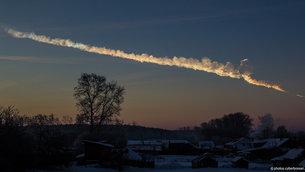
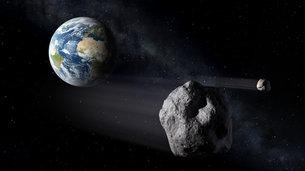
ESA's Optical Ground Station (OGS) is 2400 m above sea level on the volcanic island of Tenerife.
NEO coordination and big data

neo admin
An interesting connection between Earth Observation and NEO monitoring activities has been unveiled through the NEO Coordination Centre participation at the "Big Data From Space" meeting, held at ESRIN from 5 to 7 june 2013 (http://www.congrexprojects.com/2013-events/13c10/programme).
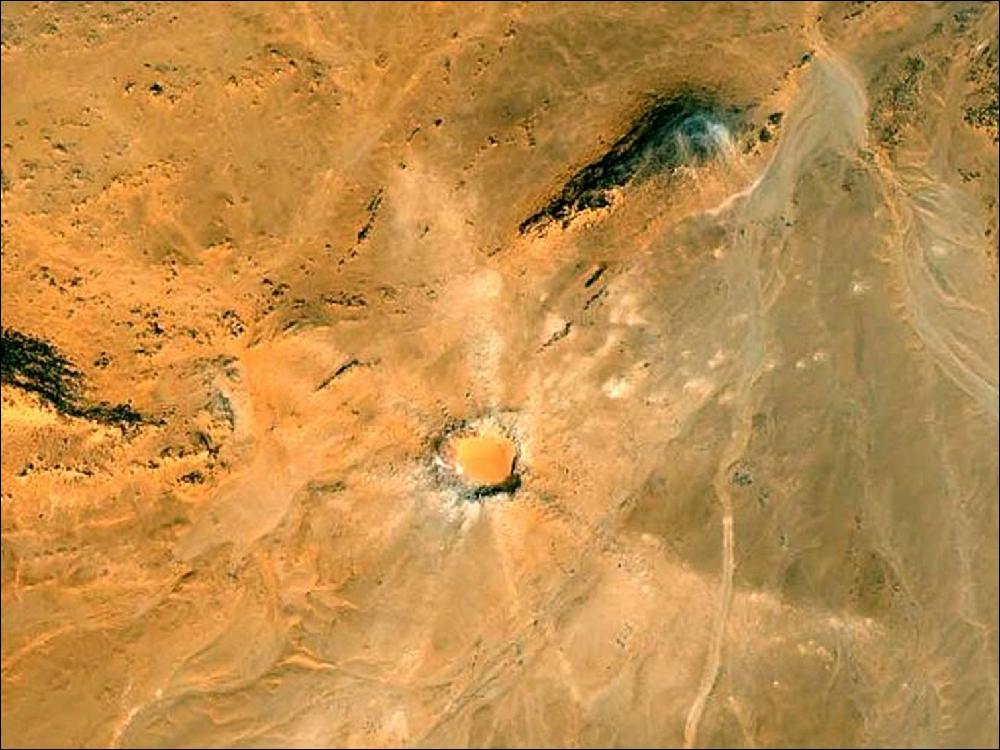
The meeting aims to timely face the challenge of the huge increase in the images flow coming from space which will characterise the next generation of Earth Observation missions. The study case presented by the NEOCC refers to the discovery and characterization of the Kamil crater, a rayed impact crater with 45 m in diameter located in southern Egypt and first identified on Google Earth in 2008.
A geophysical expedition was undertaken in February 2010, which collected several hundred kilograms of nickel-enriched iron meteorites and performed in-situ measurements.
Prior to the expedition extensive analysis of the impact site was performed by both high resolution optical images and by radar acquisitions from the Italian COSMO-SkyMed satellites (on the left - The Kamil crater floor depth is 16 m and is overlain by a 6 m-thick crater-fill material, which is consistent with a crater generated by an iron meteorite 1.3 m in diameter impacting at a velocity between 3 and 4 km/s. QuickBird Image 2009, Courtesy of Telespazio.), allowing detailed geo-morphological analysis of the features surrounding the crater and the search for secondary impacts.
The possibility of setting up an extended survey of small impact craters in inaccessible regions by using multispectral high resolution images appears then an appealing opportunity and a novel application within the "Big Data" initiative.
The utilisation of Earth Observation data for developing and implementing new services at the NEO Coordination Centre and their contribution to operations has been also discussed.
ESA NEO and Debris Detection Conference - Exploiting Synergies

operator neo
Registration is open for the ESA NEO and Debris Detection Conference - Exploiting Synergies, which will be held at ESA/ESOC, Darmstadt, Germany, 22 - 24 January 2019.
The deadline for the submission of abstracts is 1 October 2018.
The conference will highlight all classical and new disciplines of NEO and Debris Detection Research, including:
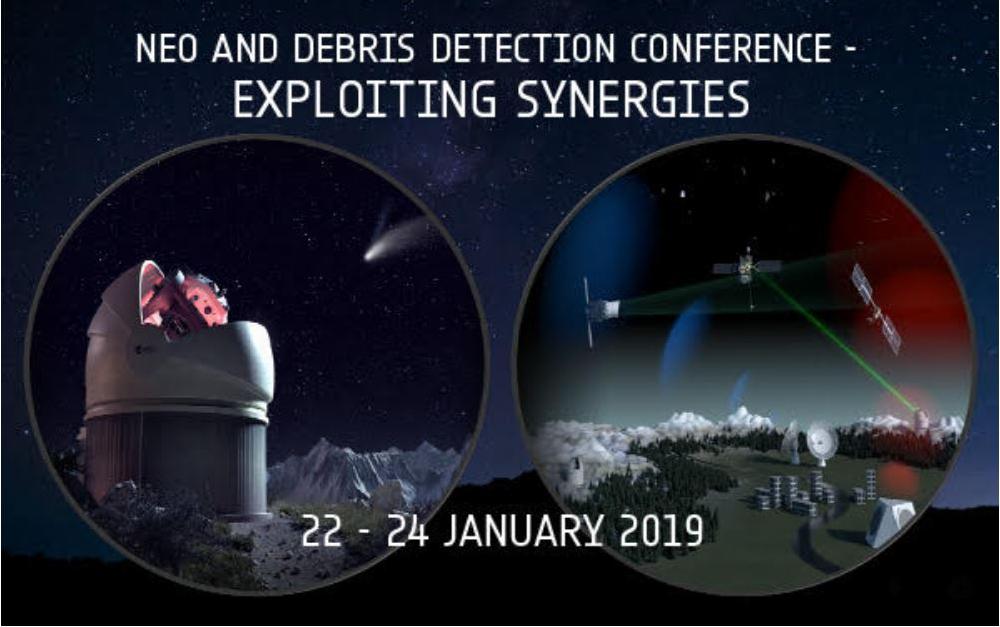
• Observation strategies - technology improvements of radar, passive optical, and laser systems
• Instrumentation component developments (CCDs, CMOS, ...)
• New telescope and radar projects (e.g. fly-eye telescope)
• Space-based observation concepts
• Space surveillance system architectures and applications
• Detection systems for fireball and other events
• Orbit prediction and determination
• On-orbit and re-entry risk assessments
• Data processing concepts
• Data exchange mechanisms and standardisation
Details on the conference venue, scope, registration, accommodation and abstract & paper submission can be found on the conference website.
We are looking forward to meeting you in Darmstadt!
With best regards from the local organisers.
ESA/ESOC,
Robert-Bosch-Strasse 5,
64293 Darmstadt,
Germany
Programme committee:
Vladimir Agapov (ROSCOSMOS), Ricardo Bevilacqua (IAA), Nicolas Bobrinsky (ESA), Richard Crowther (UKSA), Pascal Faucher (CNES), Moriba Jah (University of Texas at Austin), Lindley Johnson (NASA), Stephan Mayer (FFG), Manuel Metz (DLR), Ettore Perozzi (ASI), Thomas Schildknecht (COSPAR), Makoto Yoshikawa (JAXA)
Download the call for papers.
NEOCC orbit determination and impact monitoring software update

operator neo
About two years ago, the NEOCC announced the full deployment of its orbit determination (OD) and impact monitoring (IM) software, developed and maintained by SpaceDyS s.r.l. through industrial contracts with ESA.
In the last months, all OD data and the entire risk list have been reprocessed using an updated version of the NEOCC software, which has now been renamed "Aegis".
The main updates introduced in this new version of the software are the adoption of the JPL DE441 Planetary and Lunar Ephemerides, the introduction of a new step-size formula for the propagation of orbits during close approaches, and an improved and more stable computation of the close approaches minimum distance. All these aspects aim to improve the calculation of OD and IM data. In addition, due to deep code optimisation and conversion to a dockerised architecture, the computation of IM data is now faster than before.
Finally, it is worth noting that the calculation of the Palermo Scale has changed from the old version of the software, in which the time to impact was defined as the interval between the mean epoch of observations and the date of impact. Currently, the Palermo Scale is calculated by considering the time to impact as the interval between the last IM calculation time and the potential event epoch.
A Planetary Defense Icon. Credit: ESA
Sixth meteoroid detected prior to impact

operator neo
For the second time this year, a small asteroid has been discovered before impacting the Earth. This time the discovery came from the Catalina Sky Survey, one of the major projects dedicated to the discovery and follow-up of NEOs, and already responsible for the discovery of the first three such cases between 2008 and 2018.
The new asteroid, now officially designated 2022 WJ1, was first imaged by the 1.5-metre Mt. Lemmon telescope at 04:53 UTC on 19 November, but the object was first reported to the MPC at 05:31, once 4 observations made it detectable by the automated pipelines running at the telescope.
Within a few minutes, ESA's own internal monitoring software reported that, based on the just-published astrometry, the object had a ~20% chance of being on a collision course, possibly hitting somewhere in North America 2 to 3 hours later. A few minutes later all other impact monitoring programs also sent alerts outlining a similar scenario.
Excerpt of the first impact assessment by ESA’s tool Meerkat as reported at 05:36 UTC, indicating an impact probability of ~20%. Credit: ESA / PDO
Within minutes of the notifications, observers at the Catalina Sky Survey, and elsewhere in the US, started obtaining follow-up observations of the new asteroid. In less than 30 minutes from the initial trigger, the impact became confirmed, thanks to newly reported observations. Shortly after, even more astrometry became available, sufficient to pinpoint the location of the impact point with excellent precision: the small asteroid, likely less than a meter in diameter, was going to impact somewhere between Lake Erie and Lake Ontario, near the US-Canada border, around 08:27 UTC.
First impact corridor computed by ESA’s tool Meerkat as reported at 05:36 UTC, still showing a large impact uncertainty. Credit: ESA / PDO
And, at exactly the predicted time, a fireball event indeed happened at the expected location, observed by hundreds of people in the Toronto area and elsewhere and by many surveillance cameras. Soon, photos and videos also surfaced, providing a fantastic view of the event, and its incoming trajectory.
It is likely that fragments of the meteoroid may have survived the atmospheric entry, reaching the ground. The largest ones probably fell somewhere offshore the Southern coast of Lake Ontario, but some smaller ones may have landed near the Canadian city of Grimsby. Searches are ongoing, stay tuned!
Image of the fireball produced by 2022 WJ1 at atmospheric entry. Credit: R. Weryk
Ten years of the NEOCC web portal

operator neo
This October marks the 10-year anniversary of the web portal deployed and operated by the NEO Coordination Centre (NEOCC). Prior to that, the NEO Segment of ESA’s Space Situational Awareness Programme had released a contract for the development of the web portal with the aim to host all related NEO contents in the field. The release of the NEOCC web portal actually predated the official inauguration of the NEO Coordination Centre at ESRIN, which occurred in May 2013.
The initial portal set-up was based on federating several information sources that were available at the time plus some additional new functionalities. When released, it already included the following functionalities: the risk page and the close approaches list (as obtained from the NEODyS portal at that time), the observational priority list (as provided by INAF), an orbit and flyby visualisation tool developed for the portal, an NEA database search function and the EARN physical properties database (as provided by DLR).
The first news that we released was on 12 October 2012, where we discussed the rediscovery of asteroid 2008 SE85. The object had been discovered by the Catalina Sky Survey back in September 2008 and had been subsequently lost. An amateur astronomer, Erwin Schwab, was able to find it again by making use of ESA’s Optical Ground Station (OGS) in Tenerife, Spain.
As time passed, new functionalities were added to the portal step by step. This included: the FITS image database, a fireballs database, a discovery statistics page, the NEO chronology (as kindly provided by Karel van der Hucht) and many other pages. Further to that, our portal started providing orbits as calculated by ESA’s own orbit determination software from November 2018 and own impact monitoring information from November 2020. Some tools are also provided in the portal as the NEO Population Tool (NEOPOP) and the NEO Propagation Tool (NEOPROP). We also added the possibility to have automated access to the portal data from November of 2019.
After more than eight years in operation, we released in March 2021 a full new version of the portal adapted to new web standards. Very recently, at the end of last September, we released a set of graphical tools that represent a relevant change on how the trajectories of asteroids and their observability can be visualised.
Snapshot of the old NEOCC web portal as of February 2013. Credit: ESA / PDO
EU-ESA Workshop on NEO Imminent Impactors Warning Coordination

neo admin
The European Union (EU) and ESA’s Planetary Defence Office are organising the “EU-ESA Workshop on NEO Imminent Impactors Warning Coordination”. The workshop will take place at ESA’s European Space Operations Centre (ESOC) in Darmstadt, Germany between 12-14 December 2022 and it will be performed in hybrid mode, with a preference for the local attendance of the speakers.
This workshop will explore the possibilities of increasing the networking of parties involved in the process of discovering, acknowledging and following up NEO imminent impactors as well as their atmospheric entry. Building on the recent occurrence of the impact of 2022 EB5 on 11 March 2022, EU and ESA want to increase the level of coordination and cooperation between all those actors. This includes asteroid discoverers and observers, NEOCP object analysts, spacecraft operators and mission planners and fireball network operators. Goals of the workshop are to establish a network of related experts and a communication protocol to ensure that the relevant information about imminent impactors reaches all possible interested parties.
A link to the event web portal can be found here.
The workshop sessions are the following:
- New developments and updates to imminent impactor services
- Observatories and observation networks for imminent impactors
- Imminent impactor observation opportunities by spacecraft
- Fireball networks and other sensing capabilities
Workshop presentations have been organised by invitation of relevant speakers. Speakers and interested participants are invited to register to the event up to 15 November 2022. Ample slots have been allocated in the programme to allow discussions between the experts. A limited number of presentation slots are still available. If a workshop attendee considers having a relevant contribution in the subject and would like to present it at the workshop, please send a message to the organisers with a proposed title and abstract before 30 October 2022. A limited capacity of up to 60 people will be available for local attendance to the event. These will be available to the speakers wanting to attend in person and on a first come first serve to the rest of attendees.
Programme of the European Union, implemented by ESA.



